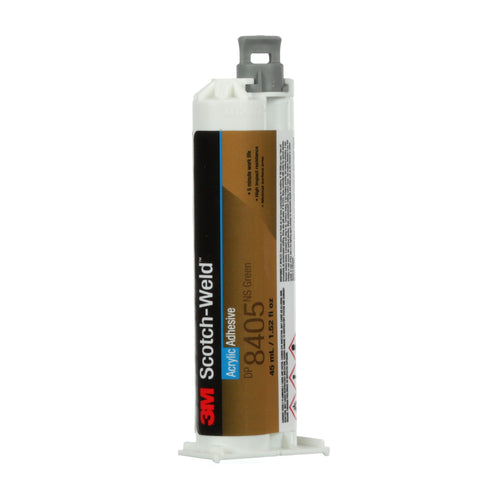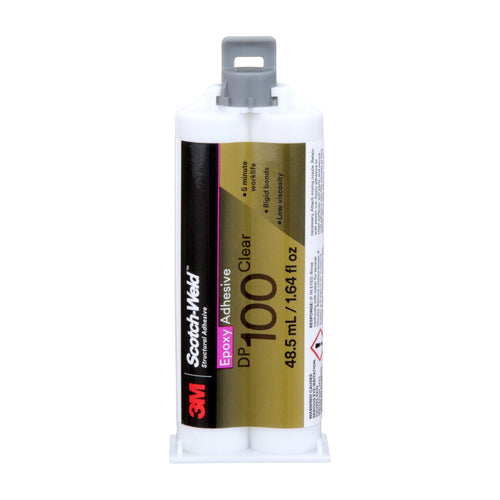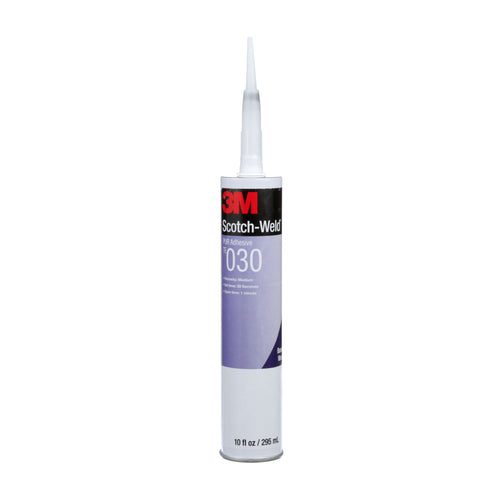Structural adhesives are used in a wide variety of applications. Unlike mechanical fasteners, like nails and screws, they do not cause damage to substrates, and, when used with metal, they do not cause distortion like welding often does. They can also be used to bond dissimilar materials and work well when the substrates have different geometries. They also play a role in the shift to composite materials. These materials reduce weight significantly but offer comparable stiffness to metal, but they are not usually compatible with welding or drilling.
Structural adhesives have the highest load-bearing capacity of all types of adhesives. They also provide exceptional chemical and environmental resistance and are usually formulated to be 100% solid. They cure in a process that provides excellent resistance to solvents and changing temperatures, and they do not require access to air or moisture to dry. A leader in the adhesives industry, 3M offers several structural adhesives that come with a wide range of characteristics, and their potential applications are numerous. The versatility of structural adhesives is a great thing, but it can also make it difficult to select the one that is best suited to your application.
What Is a Structural Adhesive and Why Should You Use One?

A structural adhesive, when fully cured, is a type of adhesive that has exceptional load-bearing capabilities. As previously mentioned, using an adhesive instead of traditional mechanical fasteners has many advantages. Screws or rivets require holes to be drilled and often leave visible protrusions on the finished product. Adhesives, on the other hand, leave the product with a clean, aesthetically pleasing joint. The stress of the load is spread evenly across the entire joint instead of having localized stress points at the screw or rivet.
Traditional fasteners can also corrode and deteriorate away. This is especially true where dissimilar materials are being joined. For example, when dealing with treated lumber, the chemicals used to make the lumber last longer can accelerate the rate of corrosion of traditional fasteners. In some scenarios, structural adhesives have an advantage when joining metal to metal, as they do not carry the potential for warping from heat as welding does.

When choosing a structural adhesive, there are things that should be taken into consideration to ensure you pick the best one to suit your particular needs. The first question to answer is what type or types of materials need to be bonded together. Think about the environmental factors such as temperature, humidity, rain, and UV exposure. Consider if the product will come in contact with salt water or petroleum-based fluids, such as motor oil, gasoline, diesel fuel, or jet fuel. Will any solvents come in contact with the bonded joint?
Mechanical challenges also play a role in determining the proper solution. Will the bonded joint be subject to frequent impact or vibration? Will the materials being joined dissipate heat at different speeds? If so, how much additional stress will be put on the joint? Last, think about the amount of stress that will be put on the joint. Knowing the answers to these scenarios will help you choose the best possible adhesive solution for the job at hand. Understanding how certain variables will impact your project enables you to choose a type of structural adhesives that is suitable to your needs. Let’s take a closer look at some of the many types of structural adhesives available from 3M.
Acrylics

Acrylic adhesives are two-part adhesives. They provide slightly less bond strength and impact resistance than epoxies but provide many other features that often make them easier to use. This solution provides the best combination of strength and design flexibility. One of the primary benefits of working with acrylic adhesives is a higher tolerance for unprepared or oily surfaces. While some types of adhesives will not stick properly if the substrates are not perfectly clean, acrylic adhesives tend to work with minimal (if any) prep work.
3M’s new acrylic adhesives are also low odor and have higher impact resistance. Acrylic adhesives also offer a faster cure time and a longer shelf-life. Faster cure times allow you to increase productivity, while the longer shelf-life greatly reduces waste. This type of adhesive can be used to bond a wide variety of substrates, including plastics, metals, and painted surfaces.
Epoxy

Epoxy adhesives generally provide the most strength and overall best performance. They also provide the best resistance to temperature, weather, and solvents. These adhesives can be used to bond wood, concrete, and metal, and there are flexible epoxy options that are suited for use with some plastics and rubbers. For the best results when using epoxies, the surfaces should be clean and properly sanded or blasted.

Epoxies are available in two categories. The first is the traditional two-part epoxy that requires mixing. The second category is a one-part heat curing epoxy, specifically for bonding metal to metal. One-part epoxies provide exceptional strength for metal-to-metal bonding without the need for measuring, mixing, and weighing two-part products. 3M two-part epoxies, however, are great for a wide variety of substrates where you do not want to use mechanical fasteners.
Urethane Adhesives

Urethane adhesives are two-component adhesives that tend to have good flexibility when cured. Urethane adhesives also have excellent impact resistance and will adhere well to most plastics. However, they can also be used to bond wood, concrete, and rubber. Urethane adhesives harden within 2 to 120 minutes, but they tend to have reduced resistance to solvents and high temperatures.
Uncured urethane adhesive components are sensitive to moisture. The curing process gives off a small amount of carbon dioxide, which may create bubbles in wider bond lines. 3M urethane adhesives work best for applications in which bonds that require flexibility between different materials are required. Urethane-based products cure quickly and allow a greater flexibility than many other types of adhesives.
PUR

3M's polyurethane-reactive adhesives, or PUR adhesives, are moisture-curing, single-component adhesives that offer the benefits of a structural adhesive combined with the speed of hot melt for a wide range of materials. 3M’s Scotch-Weld PURs offer as much as 1,000 psi in shear strength while remaining flexible. PURs cure over 24-48 hours. They are both flexible and resistant to extreme temperatures. PUR adhesives can be used with wood, plastic, polystyrene, acrylic, ceramic, metal, or glass. While these adhesives require no mixing of components, they do require a specialized applicator. An adhesive preheater is also available for the PUR line of products.
Instant Adhesives


Instant adhesives, also known as cyanoacrylate adhesives or CA for short, are single component liquid adhesives capable of bonding similar and dissimilar materials. These adhesives, which are also commonly referred to as super glue, cure extremely fast with surface moisture and pressure.
Cyanoacrylates have good adhesion and very thin bond lines. They reach handling strength in 5 to 10 seconds at room temperature and reach 80% strength in about one hour. Instant adhesives are capable of achieving tensile strength up to 5,000 psi.
One drop of a cyanoacrylate per square inch can bond ceramic, wood, metal, plastics, rubber, and many other materials. Instant adhesives can also be used with low-surface-energy elastomers and plastics when an appropriate primer is used. They are most frequently used for smaller assemblies and projects like gasket bonding.
Anaerobic Adhesives


Anaerobic adhesives are one-component, solvent-free adhesives that cure in the absence of oxygen while in contact with metal. Anaerobic adhesives remain in liquid form until air is forced out of the joint. These adhesives require the presence of metal ions, such as iron or steel, and they do not bond well to plastics, rubbers, or glass.
Anaerobic adhesives are commonly used for pipe sealing and thread-locking because, once the product is sealed between two sets of threads, it quickly hardens into a tough cross-linked plastic. These adhesives are designed to fill the spaces and irregularities between threaded parts, which eliminates the need for washers and gaskets. They eliminate unscheduled downtime caused by loose fasteners and leaks, and they can keep your factory up and running as efficiently as possible.
Adhesive Primers

While not technically an adhesive, adhesive primers can help provide the best adhesion on glass or metal surfaces. These primers are easy to apply and are suitable for liquid or film adhesives. One product, 3M Scotch-Weld Metal Primer 3910, also provides resistance to environmental exposure and offers corrosion protection to metal surfaces.

Conclusion

Structural adhesives are extremely versatile, and they come in a wide variety of types. This ensures that there is a product that is well-suited to just about any application. 3M is a leader in the adhesives industry, and the company offers a huge selection of acrylic adhesives, epoxy adhesives, urethane adhesives, PUR adhesives, instant adhesives, and anaerobic adhesives. It also has its own line of adhesive primers to help ensure strong, secure bonds for materials that are difficult to bond, like glass and metal.
When shopping for a structural adhesive, be mindful of your needs and the stresses the bond will face after the project has been completed. Research the properties of different types of adhesives to determine which are best suited to your project. When all else fails, the representatives at 3M are available to help you make the right decision.







